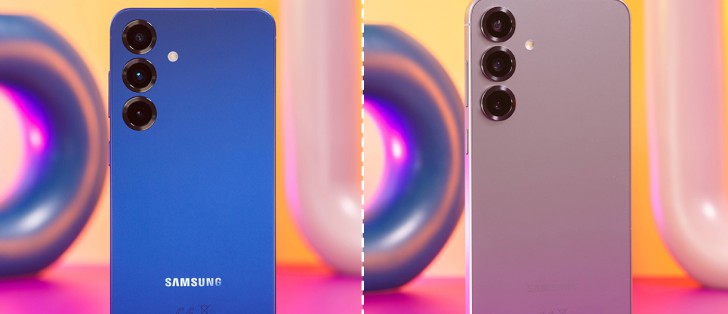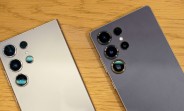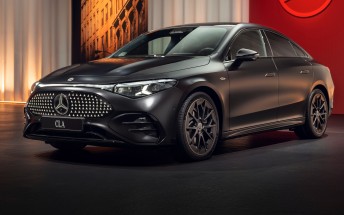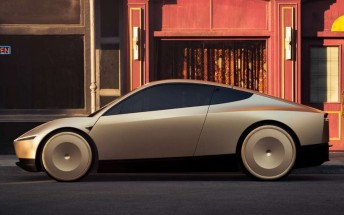Samsung Galaxy S25 vs. Galaxy S25 Plus

So, you have your heart set on a shiny new Samsung Galaxy S25 device? There's definitely plenty to love about the Korean giant's new flagship lineup. To be perfectly frank, it is a bit too similar to last year's S24 family, at least for our taste, but that's a whole other discussion. Today, we are looking at the choice between the vanilla Galaxy S25 and the Galaxy S25+.
For many, this will be an obvious choice that simply comes down to size and/or price since the two devices practically share the same hardware. Still, there are a few subtle differences here and there that might be worth pointing out.
Table of Contents:
For starters, you can compare the complete specs sheets or directly continue with our editor's assessment in the following video or in the text below.
Size comparison
Let's be frank: for most prospective buyers, size will be the big determining factor between the two devices. The vanilla S25 is a compact device with a 6.2-inch display and 146.9 x 70.5 x 7.2 mm body, tipping the scale at just 162 grams.
In contrast, you get a pretty sizeable 6.7-inch display with the Galaxy S25+. It measures 158.4 x 75.8 x 7.3 mm and weighs 190 grams, which is also quite reasonable for its size.
For better or worse, unlike Apple, Samsung doesn't offer a compact "Ultra", so to speak. If a small size is what you are after, then you have to make some hardware compromises.

One thing you won't have to realistically sacrifice, however, is build quality and materials. Sure, the Ultra still has somewhat of a leg up on the other two S25 models, but the S25 and S25+ are identical in this department and deliver big. Both phones employ a premium "glass sandwich" construction with Gorilla Glass Victus 2 on both sides and an Armor aluminum 2 frame.
Both phones also have the same IP68 ingress protection rating, which should allow them to survive for up to 30 minutes in up to 1.5 meters of fresh water.
Display comparison
Last year's S24 generation marked a rather major display upgrade. Both models received LTPO tech for more dynamic refresh rate adjustment and better power efficiency. And the S24+ got its QHD resolution back, which was absent for a few generations.
This year, however, the panels for the S25 generation seem unchanged from last year on both the S25 and S25+. We can't exactly complain about these particular panels since they still hold up very well in the modern smartphone landscape. As mentioned, both are LTPO-based and offer a dynamic 120Hz refresh rate. Also, plenty of brightness and HDR10+ certification.
To be perfectly honest, it is a bummer that Samsung is still sticking to 8-bit color depth displays on both models while most of its competitors have already advanced to 10-bit and even 12-bit color.
The display department is where we find one of the major differences between the S25 and S25+ - size. That one is obvious. But beyond screen real estate, there is also the more subtle difference in resolution. The S25+ comes with a QHD+ display, compared to the S25's FHD+. This also translates to a difference in sharpness, with the S25 peaking at around 416 ppi, compared to 513 ppi on the Plus model. To be perfectly frank, however, the real-world difference is hard to spot unless you really pixel-peep, even in person, side by side.
Battery life
A bigger phone naturally means a bigger battery. The vanilla Galaxy S25 comes with a 4,000 mAh pack, compared to 4,900 mAh on the S25+, which is almost on par with the Ultra model. That's pretty impressive power density, in our opinion, given both phones` size and weight.
Both phones offer a solid Active Use Score, but the Plus model naturally comes with a tangible bump in its overall endurance.
Charging speed
The charging speed is clearly different between the vanilla S25 and the S25+. There is something to be said about battery capacity in this regard. However, the logic isn't as simple as a smaller battery equals quicker charging times since larger batteries do have the advantage of charging quicker and taking in more current to some extent and a certain point.
Still, in this particular comparison, we also have the fact that the vanilla S25 only supports Samsung's 25W charging while the S25+ is advertised as taking up to 45W. This results in a noticeably faster charge time on the S25+, both for a full charge and a partial charge for 15 or 30 minutes on the charger.
Speaker test
The Galaxy S25 and S25+ have very similar speaker systems. Both rely on a hybrid setup, with the front-facing amplified earpiece acting as one channel and a dedicated bottom-firing speaker as the other. This intrinsically brings about some imbalance to the output, though Samsung should still be commended on how well it has combatted that through tuning.
Speaking of tuning, both phones are remarkably similar in this respect. You get very clean output. The vocals are great, and the high frequencies are well presented, but the bass is barely there.
Both phones also have Dolby Atmos on board with Movie, Music, Voice and Auto presets. There is also a specific Dolby Atmos for Games option.
Still, we have to give a slight edge to the Galaxy S25+ here since it is slightly louder, earning a VERY GOOD mark in our testing compared to GOOD on the Galaxy S25. We can only assume that the S25+ has more space to work with internally for better speaker acoustics. The difference isn't major, but it is still there.
Performance
Both the S25 and S25+ use the same Snapdragon 8 Elite chipset. Gone is the uncertainty and market segmentation from the S24 generation, where certain markets got a Qualcomm chip while others got a Samsung Exynos one. The Snapdragon 8 Elite in use here is also the higher-clocked version with a slightly boosted max speed on the two big Oryon V2 Phoenix L CPU cores.
Another difference between the vanilla and the plus models used to be the base RAM configuration, where the S24 would be available with as little as 8GB of RAM. That's no longer the case; both the S25 and S25+ now come with 12GB of RAM. The only difference is storage, where the S25 starts at 128GB, while the least you can get on the S25+ is 256GB of storage. Neither phone has expandable storage.
One thing still exclusive to the S25+ and absent on the vanilla S25 is Ultra Wideband (UWB) support.
As for software aspects, the two phones offer the exact same One UI experience and class-leading feature set, including many Galaxy AI features. Plus, both phones come with Samsung's excellent support promise of a whopping seven major OS updates.
Benchmark performance
It comes as no surprise that both phones offer excellent burst performance thanks to the top-tier Snapdragon 8 Elite chipset. There is hardly any difference in the actual performance numbers; any difference that might exist is purely run-to-run deviation.
We would say that the S25+ has a very slight advantage in sustained performance since its larger size allows it to handle thermals slightly better. It's hardly a massive difference, though.
Camera comparison
The Galaxy S25 and S25+ have exactly identical camera hardware. The particular setup is borrowed straight from the S24 and S24+, so there haven't been any major hardware changes in this department. Other than the new ISP that ships with the Snapdragon 8 Elite chipset.
As mentioned, you don't quite get the same camera prowess as the Ultra models, but the S25 and S25+ still enjoy a pretty versatile setup. On the back is a 50MP main unit and a 10MP 3x telephoto, both backed by OIS and a 12MP ultrawide. The latter lacks autofocus, which is a bit of a bummer, but Samsung continues to insist that that feature remains an Ultra exclusive.
While the selfie camera hasn't been changed either, it remains a bit of a highlight since it does feature autofocus and has proven to capture very competent stills and videos.
Speaking of videos, videography is one of the strong suits of the Galaxy S25 and S25+, just like the S24 and the S23 family before that.
Image quality
The main camera on both phones produces clean 12MP stills with a good amount of detail, wide dynamic range and punchy, yet not over-the-top colors. The image quality is just like last year.
Samsung has what we would consider pretty mature but also quite laid-back processing. That means that sharpness leaves a bit to be desired, especially when you shoot inside and not in broad daylight. We may have praised these photos 2-3 years ago, but the industry is moving rapidly, and this sort of fine detail rendition is no longer class-leading. Contrast is generally great, though some more challenging scenes can come out looking a bit flat.
The 2x crop zoom photos are more than decent. Sure, you get a bit more grain, and stills are generally softer than their 1x counterparts, but Samsung achieved lossless-like quality.




Samsung Galaxy S25: 0.6x • 1x • 2x • 3x




Samsung Galaxy S25+: 0.6x • 1x • 2x • 3x
The 3x telephoto photos are fairly decent but definitely not a standout feature of either phone. The 3x telephoto unit matches the main camera's processing in terms of colors, contrast, color temperature, etc. Detail is solid, perhaps better than you'd expect, given the 10MP to 12MP upscale action. The grain is there in the shadows if you go looking for it, but it's not getting in the way. Dynamic range and colors are great.
The ultrawide camera is far from what we would consider industry-leading. Its photos aren't terribly sharp. On the positive side, the dynamic range is surprisingly wide for this type of camera. The contrast is also solid. The colors are very well-matched to the other cameras.
Our vanilla Galaxy S25 review unit has some obvious issues with focus misalignment on the ultrawide, where the parts of the image are blurry (starting almost from the center of the frame upwards). This is not the case with our S25+ unit, and while both are technically retail units, we would like to believe that this is a one-off production quality issue with the S25.
Like many other phones, the S25 and S25+ have automatic night mode and a dedicated mode in the camera app. The automatic night mode does a pretty good job on its own, but it is a bit lax, and you can get a bit different results by using the manual night mode. The following samples are all taken with automatic night mode.
Regular nighttime photos have a laidback processing and good highlight retention but not very bright shadows. There is plenty of noise, too. The color rendition is nice.
With the 2x photos, rendition is largely comparable to that of the standard 1x, but expect a slight drop in sharpness and a further increase in noise.




Samsung Galaxy S25: 0.6x • 1x • 2x • 3x




Samsung Galaxy S25+: 0.6x • 1x • 2x • 3x
The low-light photos from the dedicated 3x telephoto are much better. You get plenty of detail and great colors.
The ultrawide camera looks good in low light (for this sort of camera). The dynamic range is on point, and the overall processing seems to match the main cameras'.
Video quality
Below, we have a few framegrabs from the videos taken by the two phones at each focal length so it's easier to compare to one another.
Unsurprisingly, the main cameras on the S25 and S25+ capture excellent 4K videos. These are sharp and detailed, with a wide dynamic range and pleasant colors. At 2x digital zoom, video quality remains great, and it seems Samsung has nailed the 'lossless' part. The 3x telephoto camera produces detailed, sharp videos with good dynamic range and colors. They are also very well matched to the main camera. The above is valid for the 4K videos from the ultrawide. They are very good (for this sort of camera), colors look nice and are well-matched to the other two cameras.
The main camera remains very competent in low-light conditions. The same goes for the 3x telephoto, which is kind of impressive given that this is a very small telephoto. The ultrawide struggles pretty badly in low-light conditions. Detail is a bit lacking, and dynamic range isn't ideal.





Samsung Galaxy S25: 0.6x • 1x • 2x • 3x • 1x low-light





Samsung Galaxy S25+: 0.6x • 1x • 2x • 3x • 1x low-light
Verdict
Unsurprisingly the Galaxy S25 and S25+ are very similar devices. Aside from some niche things like the presence of UWB on the bigger model, the difference between the two mainly comes down to size and price.
If you don't mind or even prefer the larger display and can swing the extra cash, then the S25+ delivers a bit more in a few minor but notable aspects. You get to enjoy the sharper display with a higher resolution and the faster charging speed on a bigger battery that offers better endurance. If none of this is particularly important to you, then you can probably save a few bucks and go with the vanilla Galaxy S25 instead.
Related
Reader comments
- Anonymous
- 10 Feb 2025
- PkF
You genuinely don't think you'd notice ltpo yielding like +15-30% battery life? That's crazy.











 Xiaomi
Xiaomi Samsung
Samsung Samsung
Samsung Nothing
Nothing OnePlus
OnePlus


